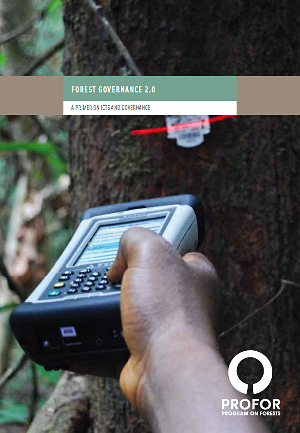
Share
Related Links
Forest Governance 2.0 (July 2011)
Attachments
Keywords
Authors/Partners
Authors: Tuukka Castrén (team leader, senior forestry specialist) and Madhavi Pillai (natural resource specialist) supported by Nalin Kishor (senior natural resources economist) at the World Bank. Funding: World Bank FLEG trust fund, PROFOR and the Government of Finland
Information Management and Forest Governance
Information technology and management in forest governance -- innovations for improved forestry outcomes
CHALLENGE
Improving forest governance and reducing forest crime requires reforms regarding: legislative framework, public institutions, private sector operations, and civil society participation to name a few. Many countries have already reformed their forest legislation and institutions. It is essential to recognize that in order to actually achieve improved forest outcomes, reforms need to be both planned properly and implemented effectively at all levels.
Modern information technology, including remote sensing and field level applications, can help in this regard. Such technology has proven valuable in many fields in promoting good, transparent and equitable governance, and is also required to ensure sustained implementation of reforms. Some countries have introduced systems, for example, to better track log sales and timber flows, use remote sensing technologies to track encroachment, and engage with local communities with mobile applications. In many cases, the role of information and communications technology (ICTs) in the forest sector has been limited to providing information on ‘how much forest is there’ and how to manage the resource. However, information management is not only about new technologies. Efficient dissemination of forest-related information can also be done through more traditional media if properly planned. Whatever the technology chosen, improving information management is an essential part of forest governance reforms.
APPROACH
To address these challenges, the World Bank’s Forests Team, supported by PROFOR, prepared a study on information technology and management in forest governance, building on the framework developed in Building Blocks for Good Forest Outcomes: An Analytical Framework for Governance Reforms (2009).
The project’s objectives are to: identify and apply ICT applications to improve forest governance in the Lao People’s Democratic Republic (Lao PDR) and Moldova; and strengthen ICT development capacity in the forest sector in these countries. The project also provides field-tested experience for further support by the Bank and other development partners.
RESULTS
The resulting study, titled Forest Governance 2.0: A Primer on ICTs and Governance, explores a whole range of ICT uses, including increasing public participation and improving law enforcement and economic efficiency, to improve governance in the forest sector. It draws on current and planned initiatives, both from within and outside the sector, from secondary sources and country reports from Finland, Ghana and Uganda. The study emphasizes simple, low-cost tools that will spur the demand and supply of good governance by increasing the engagement of key stakeholders in the process. The report identifies 10 key principles for developing ICT interventions for forest governance.
The experiences from Lao PDR and Moldova demonstrate that a gradual, stepwise approach to e-development is feasible or even preferable compared to large-scale sudden changes, particularly where existing e-knowledge is limited. Once initial awareness has been built, more ambitious ‘leapfrogging’ can be launched.
This project has already had a notable impact on Bank engagement, particularly in Moldova, for which the Bank has developed a forest policy note that focuses on institutional development, including improved information management. In Laos PDR, work undertaken thus far has informed both Bank operations and bilateral projects in the country.
Findings will continue to be shared on this page as they become available. Follow us on twitter or join our mailing list for regular updates.
For stories and updates on related activities, follow us on twitter and facebook , or subscribe to our mailing list for regular updates.
Author : Authors: Tuukka Castrén (team leader, senior forestry specialist) and Madhavi Pillai (natural resource specialist) supported by Nalin Kishor (senior natural resources economist) at the World Bank. Funding: World Bank FLEG trust fund, PROFOR and the Government of Finland
Last Updated : 06-16-2024








